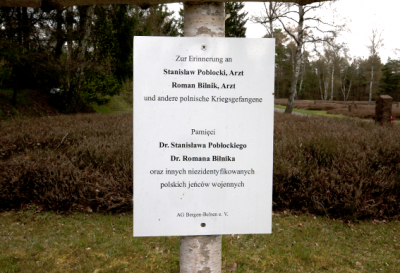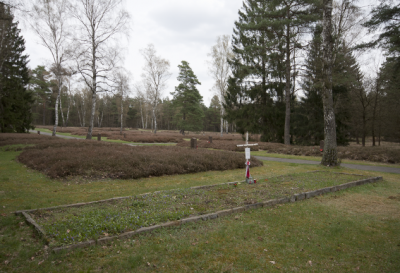Bergen-Lohheide
Only the personalities of two Poles buried in individual graves are known:
POBŁOCKI STANISŁAW Doctor of Medicine
Captain of the Polish Army
* 14.2.1890 Lina
† 11.1.1942
BILNIK ROMAN Doctor of Medicine
Second Lieutenant of the Polish Army
* 28.1.1891 Zawiercie
† 24.1.1942
They both worked in the camp hospital and died during the mass dying of the Russians due to cold, lack of food, medical and hygienic supplies, probably sharing the fate of thousands of victims of the typhus epidemic.
In 1958, individual graves of Italian soldiers were moved to the Italian plot at the cemetery in Hamburg-Öjendorf. In the years 1964-1968, the cemetery changed its appearance - individual graves disappeared, except for one, in which Elżbieta Głazowska was buried. Russian commemoration signs in the form of a monument and a gate with inscriptions in Russian and English were removed from the area of the entrance. New passages and alleys were made, running partly over the graves, and the main entrance was moved. The monument of "Die Trauernde" (The Mourning) by a Ukrainian sculptor Mykol Muchin was moved to the edge of mass graves. In 1968, a memorial stone was placed there, with a text in German and Russian:
IN MEMORY OF RUSSIAN SOLDIERS, MANY OF WHOM DIED HERE DURING WORLD WAR II
[translated from Polish]
In 1980, unknown perpetrators destroyed the monument. A year later, a copy replaced it, and the original, after restoration works, was placed in the Bergen-Belsen Memorial Site as part of permanent exhibition.
After the end of hostilities, the documents of Stalag XI C Bergen-Belsen were handed over to the Soviets in accordance with the provisions of the Geneva Convention. They remained inaccessible in the archives of the Red Army and Secret Service. It was only after the fall of the Soviet Union that the documents, including lists of names of Russian prisoners of war buried at this cemetery, were made available by the archives of the Ministry of Defence of the Russian Federation. It can be assumed that the Polish Military Mission, also operating in the occupied German territories, received letters of names of the buried Poles, which may possibly be included in the Warsaw archives of the Ministry of National Defence.
It was not until 2012 that members of AG Bergen-Belsen e.V. became interested in the small plot for Polish prisoners of war. After reading the incomplete documentation concerning these graves, which is kept in the archives of the Bergen-Belsen Memorial Site, they decided to commemorate the burial place of Poles and, above all, to draw the attention of the cemetery visitors to it. It was decided to place a symbolic soldier's birch cross with a plaque attached to it with an inscription in Polish and German:
Pamięci
Dr. Stanisława Pobłockiego
Dr. Romana Bilnika
oraz innych niezidentyfikowanych
polskich jeńców wojennych
In memory of
Dr. Stanisław Pobłocki
Dr. Roman Bilnik
and other unidentified Polish
prisoners of war
On the 1st of November 2012, a modest ceremony was held at the newly erected cross. For years Elżbieta Nikolajczyk, a member of the AG Bergen-Belsen e.V. association, who designed a new metal commemorative plaque, looked after the Polish war graves. The association as temporary treats the late but necessary commemoration, as it wishes to draw attention to the lack of such commemoration, hoping to attract the responsible persons and institutions in Poland and in Bergen-Belsen. This small, so far forgotten plot is equally worthy of attention during other official commemoration ceremonies as other graves from that cemetery.

